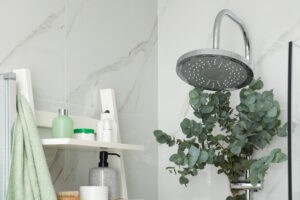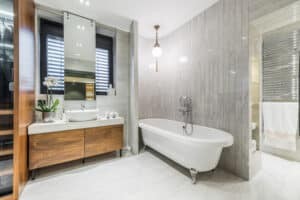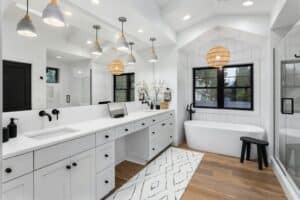Remodeling your bathroom enhances your home’s value, but adding a completely new one can be a game-changer, especially if space allows. The cost to install a bathroom varies significantly, ranging from $9,000 to $50,000 when converting an existing space, like a basement, attic, or bedroom. Adding square footage for a new bathroom can escalate costs to $37,000 to $74,000. This guide breaks down the key factors influencing these costs and offers tips to save money.
Factors Affecting the Cost to Install a Bathroom
Whether you’re repurposing a room or adding new construction, several factors impact the final cost of your bathroom installation project.
New Bathroom Cost by Location
Converting existing space is generally more economical, costing about 50% less than new construction. However, the specific room matters. Converting a laundry room is typically cheaper than an attic or closet because it’s easier to connect to existing plumbing.
Here’s a comparison of bathroom costs by location:
| Bathroom Location | Cost Range |
|---|---|
| Laundry room bathroom | $6,000–$13,000 |
| Garage bathroom | $8,000–$25,000 |
| Basement bathroom | $9,000–$16,000 |
| Attic bathroom | $9,000–$36,000 |
| Upstairs bathroom | $15,000–$50,000 |
| Bedroom bathroom | $15,000–$50,000 |
| New bathroom addition | $37,000–$74,000 |



Cost of Adding Bathroom Features
The features you choose significantly influence the total project cost. A half bathroom is less expensive than a full bathroom, and a large primary bathroom is the most costly option.
Here’s a breakdown of costs for various bathroom features:
| Type of Feature | Cost |
|---|---|
| Floors | $2–$20 per square foot |
| Light fixtures | $200–$1,000 |
| Toilet | $400–$800 |
| Sink | $400–$1,000 |
| Cabinets | $450–$3,000 |
| Shower | $1,500–$6,800 |
| Vanity and countertops | $2,500–$3,500 |
| Bathtub | $3,000–$7,000 |
Floors Addition Cost
Flooring costs vary widely depending on the material. Vinyl and laminate can range from $2 to $5 per square foot, while natural stone or hardwood may cost $15 to $20. Tile is a popular, inexpensive option, but installation can be labor-intensive. Luxury bathrooms with custom ceramic tile can exceed $25 per square foot.
Light Fixtures Addition Cost
Adequate lighting is essential for functionality. Smaller bathrooms may only require vanity lighting, while larger bathrooms may need overhead lights. New light fixtures can cost $200–$1,000, not including electrical work.
Toilet Addition Cost
Even a small powder room requires a toilet, typically costing $400–$800. Specialty units with dual flushing or a bidet will increase the price. High-end toilets with features like heaters and lights can cost thousands.
Sink Addition Cost
Sinks usually aren’t included with countertops and cost an additional $400–$1,000. Ceramic is the most common and affordable material, but options like cast iron, steel, glass, and copper offer unique aesthetics. Natural stones, such as quartz and granite, are the most expensive. Faucets and drain hardware are purchased separately.
Cabinetry Cost
Maximize storage with good cabinetry. Premade fiberboard cabinets are the least expensive, starting at $450 per set. Custom or hardwood cabinets can cost up to $3,000 but are more durable. Choose materials that can withstand bathroom humidity.
Shower Addition Cost
Installing a new shower ranges from $1,500–$6,800. A prefab unit with a shower pan and surrounds is the most economical. Additional shower heads and faucets increase the cost. Exhaust fans, required in all bathrooms with showers, can add another $300–$600.
Countertops Cost
Bathroom countertops aren’t usually included with vanity cabinetry. They need to withstand water, humidity, and personal care products. Laminate and tile are less expensive and easy to install but are more prone to damage. High-end options include natural stone and solid-surface composites.
Bathtub Installation Cost
Installing a bathtub can cost $3,000–$7,000, depending on the style, material, and surrounds. Acrylic and fiberglass tubs are on the lower end, while large granite or copper soaking tubs are more expensive. Walk-in tubs are the priciest but offer convenience for those with limited mobility. Ensure adequate floor space to comfortably move around the bathtub, especially if it’s freestanding.
Additional Factors Influencing Bathroom Addition Costs
Besides materials and location, other factors affect the overall cost.
Labor Costs
Labor accounts for about half of bathroom installation costs. The project requires licensed subcontractors, including plumbers ($75–$130 per hour) and electricians ($40–$120 per hour). Carpenters, concrete or drywall contractors, and HVAC professionals may also be needed. Hiring a general contractor to oversee the project can add another 10% to 20% to your total cost.
Permits and Inspections
Adding a bathroom requires building permits, costing at least $100, depending on the location. New bathrooms must meet health, safety, and building codes, necessitating multiple inspections. Check local government websites for specific requirements.
Location in Home
Expanding your home’s layout is roughly twice as expensive as converting existing space because it requires cutting into the home’s structure, a more complex and time-consuming process.
Bathroom Size
The bathroom’s size and type significantly impact the cost. A small bathroom is much less expensive than a large or primary bath in terms of both materials and labor. A three-quarters bath omits the tub, while a half-bath leaves out the shower.
Benefits of Adding a Bathroom
An additional bathroom provides convenience and privacy, especially beneficial for large families. While costly, starting from scratch allows you to customize the layout to your exact needs.
Adding a bathroom increases your home’s value, though not as much as some other improvements. According to Remodeling magazine’s 2022 Cost vs. Value report, a mid-range bathroom installation has a return on investment (ROI) of 51.8%, and a high-end bathroom addition has an ROI of 51.5%.
Consider whether the increased home value justifies the cost and the construction period, typically two to four weeks. Remember that another bathroom will increase utility costs and add another space to clean.
How to Save Money on a Bathroom Addition
While DIY isn’t advisable for a bathroom addition, you can still reduce costs:
- Work within the existing layout: Adding an interior bathroom is cheaper than extending square footage.
- Use existing plumbing and wiring: Locating the new bathroom near existing plumbing can reduce new plumbing requirements.
- Minimize size and square footage: Opt for a half-bath or three-quarter bath instead of a full bath.
- Source your own materials: Contractors mark up materials, so sourcing them yourself can save money.
- Choose less expensive materials: Consider synthetic materials like laminate and vinyl.
- Look for prefabricated units: Especially for cabinetry and shower stalls.
- Get multiple estimates: Obtain quotes from several local contractors, but be wary of prices that are significantly higher or lower than others.
Professional vs. DIY Bathroom Addition
Bathroom additions are generally not suitable for DIY due to the complexity and the need for specialized trades.
Professional Bathroom Addition Process
- Consultation: Meet with a bathroom designer, architect, or remodeling contractor for planning, which involves a design fee.
- Inspection: Hire an inspector to check for asbestos, lead, mold, or structural issues that could increase costs.
- Demolition: Contractors remove interior or exterior walls to make way for the new bathroom, including plumbing and wiring.
- Structural Work: A general building contractor constructs the new structure if building out or up, which may involve carpenters, concrete finishers, roofing contractors, and painters.
- Plumbing and Electrical: Licensed plumbers and electricians extend plumbing and wiring to the new space.
- Ventilation and Waterproofing: Contractors ensure proper ventilation and waterproofing to prevent water damage.
- Finishing: Install cabinetry, vanity tops, shower/tub wall materials, plumbing and electrical fixtures, hardware, flooring, and the toilet.
DIY Bathroom Addition Limitations
Unless you are a licensed professional, it’s best to avoid DIY plumbing or electrical work. You may handle minor finishing tasks, but professionals should complete the bulk of the job.
Is It Worth It to Add a Bathroom?
Adding a bathroom is a significant investment. Consider labor costs, materials, and the disruption of construction. However, the extra space and convenience may be worth the cost. You can also expect about a 50% return on investment when selling your home. Obtain estimates from at least three contractors to secure a fair price.
FAQ About Adding a Bathroom
Can you add a bathroom anywhere in a house?
Yes, but the size of the existing space may limit the amenities you can install. A half bath can be created in as little as 15–20 square feet. Adding a bathroom far from existing plumbing is more expensive, and new additions cost twice as much as working within existing rooms.
Is it hard to add a bathroom to a house?
Converting existing interior space is easier and cheaper than adding to your house, costing about half as much and taking approximately half the time.
Do I need a permit to add a toilet?
Many states require permits for bathroom remodeling, especially when modifying plumbing for a toilet. Check your city’s building codes.
Can I turn a laundry room into a bathroom?
Yes, laundry rooms are often the easiest and least expensive to convert. Drains and vents for a sink already exist, along with water service. Additional drain lines and vents will be needed for the toilet.